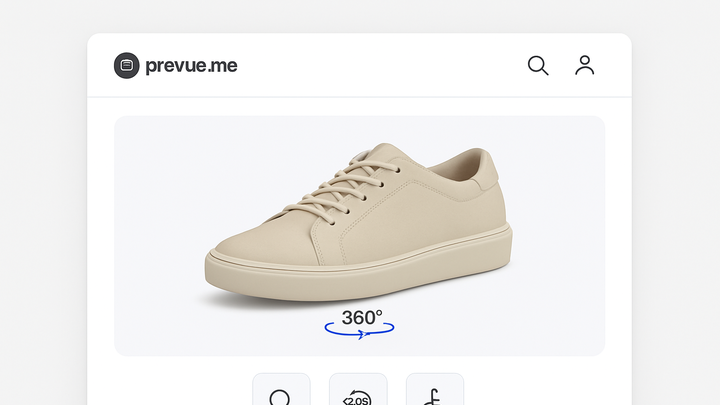Published on 2025-06-29T22:07:57Z
What is a Product Page 360 View? Examples & Best Practices
In e-commerce, a Product Page 360 View is an interactive feature that lets potential customers rotate and examine a product from multiple angles within their web browser. This immersive presentation fosters trust by providing a more realistic and detailed representation than static images alone. By increasing user engagement and dwell time, 360-degree views can contribute to higher conversion rates and improved SEO signals like lower bounce rate and longer session durations. Implementing a high-quality 360 view requires attention to performance, accessibility standards, and seamless integration – areas where tools like Prevue.me can provide actionable critiques and optimization recommendations across CRO, UX, SEO, and accessibility. From choosing between sprite-based sequences and WebGL models, to ensuring proper alt text and schema markup, a successful 360 view balances visual richness with performance and inclusivity. When measured effectively, this feature can yield notable improvements in add-to-cart metrics, reduce returns, and elevate overall user satisfaction.
Product page 360 view
An interactive product display allowing shoppers to rotate and inspect items in 360°, boosting engagement, conversions, SEO, and accessibility.
Importance of a 360-Degree Product View
Interactive 360-degree views are more engaging than static images, helping to build trust and inform purchase decisions by offering a comprehensive product perspective.
-
Enhanced user engagement
A 360 view allows users to interact with the product visually, increasing time on page and reducing bounce rates.
- Interactive exploration:
Users can rotate, zoom, and inspect products from all angles, creating a deeper connection.
- Emotional connection:
Seeing the product in detail boosts confidence and perceived value, driving conversions.
- Interactive exploration:
-
Improved conversion rates
Interactive visuals lead to better-informed purchase decisions, reducing hesitation at checkout.
- Reduced buyer's remorse:
Clear visualization decreases post-purchase dissatisfaction and return rates.
- Higher add-to-cart rates:
360 views can increase add-to-cart by up to 30%, per industry benchmarks.
- Reduced buyer's remorse:
-
Seo benefits
Rich media can improve dwell time and page quality signals, which may boost search rankings.
- Increased dwell time:
Visitors interacting with a 360 view stay longer, signaling engagement to search engines.
- Structured data markup:
Adding schema for product visuals can enhance rich snippets in SERPs.
- Increased dwell time:
Implementing a 360-Degree View on Product Pages
Select the right technical approach and integrate with tools like prevue.me to optimize CRO, UX, SEO, and accessibility.
-
Image sequence vs. webgl solutions
Choose between simple sprite-based spin viewers and advanced 3D models rendered in the browser.
- Sprite-based viewers:
Use a series of 36+ images for a basic spin effect; easier to implement but less dynamic.
- Webgl & 3d models:
Offers true 3D interactivity and zoom but requires more development and browser support.
- Sprite-based viewers:
-
Integrating with prevue.me
Leverage prevue.me for automated critiques and optimization suggestions across CRO, UX, SEO, and accessibility.
- Actionable cro feedback:
prevue.me highlights UI elements causing drop-offs and suggests improvements.
- Accessibility audits:
Ensure 360 viewers are keyboard-navigable and work with screen readers per WCAG guidelines.
- Actionable cro feedback:
-
Performance & loading strategies
Use lazy loading, compression, and CDN distribution to minimize page speed impact.
- Lazy loading:
Load 360 assets only when users scroll to the product section.
- Compression & formats:
Use optimized JPEG/PNG for 2D sprites or Draco-compressed glTF for 3D models.
- Lazy loading:
Best Practices and Common Pitfalls
Ensure your 360 view delivers maximum impact by following design and technical best practices while avoiding frequent mistakes.
-
High-quality imagery
Always use high-resolution, color-consistent images to ensure a professional appearance.
- Consistent lighting:
Maintain uniform light sources to avoid distracting shadows.
- Accurate color representation:
Ensure product colors are true to life to reduce returns.
- Consistent lighting:
-
Mobile optimization
Ensure touch gestures, pinch-to-zoom, and responsive layouts for mobile users.
- Touch controls:
Support swipe and drag gestures for rotation.
- Performance on 3g/4g:
Optimize assets for slower networks to maintain usability.
- Touch controls:
-
Avoiding seo and accessibility issues
Implement alt text, structured data, and ARIA roles properly.
- Alt text & transcripts:
Provide descriptive alt attributes or transcripts for non-visual users.
- Aria roles:
Use role=‘application’ when appropriate to ensure screen reader compatibility.
- Alt text & transcripts:
Measuring Success of 360-Degree Views
Track key metrics to evaluate the impact of 360 views on engagement, conversions, and SEO performance.
-
Engagement metrics
Monitor time on page, spin interactions per session, and depth of interaction.
- Interaction rate:
Percentage of visitors who engage with the 360 viewer.
- Average interaction duration:
Average time spent using the viewer per session.
- Interaction rate:
-
Conversion metrics
Compare add-to-cart rates, bounce rates, and purchase conversions before and after implementation.
- Cart abandonment:
Analyze rates before and after implementation to identify changes.
- Conversion lift:
Measure uplift in completed purchases attributable to the 360 viewer.
- Cart abandonment:
-
Seo performance
Assess organic traffic changes, dwell time, and SERP visibility improvements.
- Dwell time increase:
Greater time on page due to interactive content.
- Rich snippet appearance:
Track product page snippets enhanced by structured data.
- Dwell time increase:
